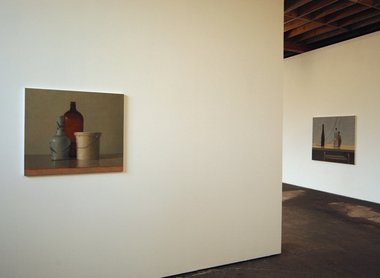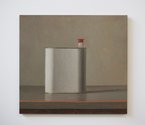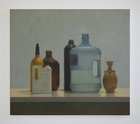John Hurrell – 29 October, 2010
It will be interesting to see where Rae goes from here, if she moves towards the more social thematic content implied in her previous solo shows at Jensen, or stays ensconced within the quietist contemplative tradition of Vermeer, Chardin and Morandi. For this former director of South Island Art Projects (a precursor of The Physics Room) this current show could be interpreted as backtracking - a bit of a retreat.
A Baker’s Dozen still lifes are presented by Jude Rae here at Jensen’s - nine oils (eight in gallery, one in office) and four watercolours. The oils demonstrate the artist’s skill at rendering the effects of light when raking across ceramic objects on a shelf, or passing through blue plastic bottles of drinking water. She blends a Morandilike obsession with lined up chinaware and spatial projections, with the softly muted colour control Chardin used to show the behaviour of light on solid forms.
The more intimate smaller paintings of angularly planed chinaware work best. There are a number of reasons.
Firstly their warm tones (with no transparent icey plastic or watery blue) enhance the Chardinesque ambience, and the use of fewer, often lower, objects concentrate the viewer’s gaze. The humbleness of the functional items gets accentuated this way, and the scanning spread of the gaze is strictly limited: not too high, not too wide.
Both sorts demonstrate the artist’s interest in reflection, especially in that of the bench’s glossy top plane, and also a use of a red undercoat that besides providing a chromatic warmth helps delineate a thin horizontal line that could be the undercoat of the rendered shelf, or the undercoat of the painting you are looking at.
With the larger works the more spread out and complex compositions are also ambiguous in their interpretative possibilities. The overlapping, various shaped forms could almost be a crowd of differently proportioned people standing on a street, or the glowing blue-bottled water a section of window with outside sky.
It will be interesting to see where Rae goes from here, if she moves towards the more social thematic content implied in her previous solo show at Jensen, or stays with the quietist contemplative tradition of Vermeer, Chardin and Morandi. For this former director of South Island Art Projects (a precursor of The Physics Room) this current show could be interpreted as backtracking - a bit of a retreat.
John Hurrell
Recent Comments
Clem Devine
"It is more about manipulating signs or juxtaposing tropes, inventing new conveyances of meaning by discovering the ramifications of putting ...
John Hurrell
Now let's stick with Jude and not digress with GF. Your point about painting plastic bottles is interesting, because I ...
Clem Devine
Yes John I know Jude has been painting these empty vessels (or are they empty?) for a loooonnnngggg time as ...







 Two Rooms presents a program of residencies and projects
Two Rooms presents a program of residencies and projects Advertising in this column
Advertising in this column



This Discussion has 10 comments.
Comment
Jude Rae, 5:19 p.m. 31 October, 2010 #
Ah John, that old chestnut...
As you know, I support social engagement, but I do wonder about the effectiveness of overtly "political" art. At best it displays the futility of preaching to the converted, at worst, it slides into complacency and voyeurism.
You refer to the large painting Beirut 2006, exhibited in 2008 at Jensen, based on web coverage of Lebanese civilians watching the destruction of the July War. The initial drawings were part of "Work in Progress", a project at Jonathan Smart Gallery in October 2006. The aim of the project was to interrogate the relationship between social engagement and the meditative aspects of art within my own practice, to find some reconciliation between the demands of so-called "high" art with the grim realities of global politics.
While the project was effectively realised (selling pencil portraits of local people raised more than $4000 for mine removal in Lebanon), I felt it failed to adequately articulate the critical complexities that had prompted my enquiry. The old chestnut (the active vs the contemplative life) remained unassailed.
The powerful thesis posited last century comes to mind: that art would progressively "de-materialise", leaving a distilled form of art that might be a kind of embodied philosophy, a form of reflection based on social practice. "Relational aesthetics" clearly informs a significant part of contemporary art practice, but it is equally clear that many western artists are reassessing and drawing on tradition, their own and (with increasingly global access) also others. While this brings all sorts of risks and pitfalls, these often ancient material practices still take us beyond philosophy into aspects of human experience which are inexplicable, offering a quiet, relatively safe place from which to observe the profound terror (and wonder) of our own limits.
It took two years to transform the web image that gave rise to Beirut 2006 into a painting. My ability to approach that task with any sort of authority relied on my primary interest in painting per se (in particular, the challenges that come with an interest in the western tradition of so-called "representational" painting) as well all I could muster of the "blind faith and grim stubbornness" that Helen Garner ascribes to the life of a serious artist.
As many of the greatest 20thC painters found (Cézanne, Matisse, Morandi, Guston...), still life was the laboratory of painting. It revealed the central mystery of this ancient art - that it is both image and object; illusion and materiality. It remains one of the toughest and most rewarding genres for a serious interrogation of painting. To suggest otherwise is only marginally more sophisticated than dismissing still life as a "parlour" pursuit.
So, is it a choice between the active and the contemplative life, John? My experience is that doing anything with integrity is much more complicated than this old chestnut suggests. Even writing art reviews...
Andrew Jensen, 6:08 p.m. 31 October, 2010 #
“The time which we have at our disposal every day is elastic; the passions we feel expand it, those that we inspire contract it, and habit fills up what remains” Marcel Proust
The finest of Jude Rae’s paintings offer us the opportunity to step into an elastic sliver of time. In this expanded measure, Jude’s and her paintings accept the uncertainty of vision, the deceit of image and the instability of transmission and reception vis a vis our position of viewer and her position as artist. Her ability to both expand and place us inside a fugitive moment is the gift of the work. Be it an idiosyncratic collage of gas canisters, plastic bottles or oil cans, the heroic anonymity of Heathrow Terminal 5 or the reconstituted pixils of Beirut, the painting must ultimately justify itself on its own terms.
The allure of a “socially thematic” position is that it removes responsibility, for either artist or viewer, of attending to this conundrum. It allows you to go straight to “Explaining Things”, take the prize money, pass go and head straight to the recyclers for Round 2. For art commentators it provides the twin relief of not having to attend to mystery of the object itself, complete as it is without explanation and without thin “socially thematic” justification. All that remains is to retreat into habitual "attitude" to fill up the remaining space....
AJ
John Hurrell, 12:20 a.m. 1 November, 2010 #
It is unfortunate, Andrew, that you chose to compare Jude's work with Dan's. Arps is a sculptor who is especially successful at making 'mysterious objects' - when he chooses to do so. Though that aspect probably isn't especially salient in his Walters project which is more about systems and layering.
Personally I think the importance of the social in art practice is ludicrously over emphasised, but it is curious that Jude has moved out in a certain 'global' direction and then stepped back from it - as is her right of course. It is also the right of any observer to suggest that the artist's stepping back might be a retreat to the formulaic, an avoidance of risk-taking. It is as if she went running up to the water's edge, dipped her toe in, liked the temperature and waded out a small distance, before having a change of heart and quickly getting out.
Andrew Jensen, 10:32 a.m. 1 November, 2010 #
It is unfortunate John you you have chosen to respond to my post rather than Jude’s. I guess if my ‘snip’ at the “prize” allows you to wriggle out of that then this would be an opportunity lost. It is unfortunate that having said the the “social is ludicrously over emphasised” you then set about doing just that....a retreat to the formulaic response perhaps? Its unfortunate to have the writing not deal with the complexity of painting, of material and of content. And it is really unfortunate if this “Punch & Judy” show back and forth precludes you responding to Jude with the consideration it deserves.
AJ
John Hurrell, 11:02 a.m. 1 November, 2010 #
It is indeed fortunate that you and Jude have sent very considered responses to this site, and also fortunate that readers can assess for themselves the accuracy of what the three of us have independently been saying.
Clem Devine, 11:22 a.m. 2 November, 2010 #
I might be a simpleton but these works are just fantastic. John you may be right in your comment about a 'retreat' from the 'political' but the political is so boring.
I like the written jousting but these art conversations get way too formal and high brow for my liking. I rather prefer straight talking.
Andrew lets not compare this work to Arps and his 'mysterious objects' that are raised into 'another realm' (Toldoli)
One day I'll be able to afford one of these paintings. Best, C.
John Hurrell, 11:15 p.m. 3 November, 2010 #
Clem and Veronica, if you look at the context of this show (Jude's painting history) you'll notice she has been painting still lifes for some considerable time now. Well so what, you might counter, perhaps she is getting better and better. And yes, she should be 'be true to her own self' for sure, but remember still life is a widely prevalent genre. Her practice I would argue is not as unique as say the +/- musicality of Walters' koru paintings, or the multiple trajectories of Bernard Frize's 'many handed' works. Perhaps it is time to change,not necessarily towards the global or social, just a new direction, any direction. Saying such things is not going to endear a critic to any artist, who most likely will dig their heels in. Yet it is a valid thought to consider - I think - even if it ends up in the rubbish bin.
Clem Devine, 10:03 a.m. 4 November, 2010 #
Yes John I know Jude has been painting these empty vessels (or are they empty?) for a loooonnnngggg time as you say 'so what'? She can do what she likes. Personally I rather liked her earlier studies of bed sheets, duvets, white fabric etc.
I've seen artists change for the sake of it. I don't think your thought is that valid in the context of an artists practice, which at the end of the day is all an artist really has. You can learn to paint, but you can you paint a plastic bottle like Jude Rae? No.
Anybody seen what Graham Fletcher is up to these days, geeze, how do you get from splodgy chemical paintings to still life living rooms?
John Hurrell, 10:20 a.m. 4 November, 2010 #
Now let's stick with Jude and not digress with GF. Your point about painting plastic bottles is interesting, because I believe art is not solely a matter of craft skills - nor is it philosophy or literature. It is more about manipulating signs or juxtaposing tropes, inventing new conveyances of meaning by discovering the ramifications of putting materials or images together in certain ways.
Because of this those sheet works you mention are more interesting because of their ambiguity. Was there once a body on top or was it underneath? Is it a shroud or a sheet? And I wonder if there is a connection with much younger later artists like John Ward Knox?
Clem Devine, 1:52 p.m. 4 November, 2010 #
"It is more about manipulating signs or juxtaposing tropes, inventing new conveyances of meaning by discovering the ramifications of putting materials or images together in certain ways."
Yes good point John. If you argue that point on this show and recent JR output you have a case.
JWK wall work, although I didn't see it in situ looked fabulous in the photographs. I guess there could be a connection from JR's older work to younger artists. Those sheet works were great for the reasons you mentioned, they were loaded.
Participate
Register to Participate.
Sign in
Sign in to an existing account.